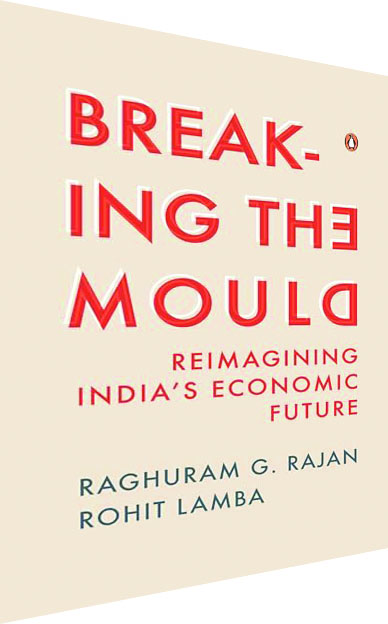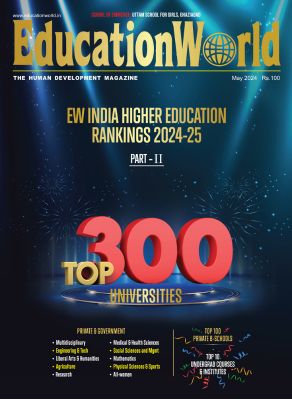 Breaking the mould: Reimagining India’s economic future
Breaking the mould: Reimagining India’s economic future
Raghuram Rajan & Rohit Lamba
Random House
Rs.799
Pages 366
This book contains an impressive array of aspects/data points to argue that India’s seemingly impressive economic growth has been very patchy
Raghuram Rajan, former Governor, RBI and former chief economic advisor to the Union government, needs no introduction to knowledgeable citizens. This book is written in co-authorship with Rohit Lamba, an alumnus of Princeton and Cambridge universities, who worked as an economist in the office of the chief economic advisor and is currently visiting assistant professor of economics at New York University, Abu Dhabi. That’s an impressive partnership.
Unsurprisingly, Breaking the Mould contains an impressive array of aspects/datapoints to support the contention that India’s reportedly impressive economic growth has been very uneven. The authors emphasise that our main focus ought to be to maximise the growth potential arising out of our demographic dividend. In 2020, after three decades of strong growth, 35 percent of our children below 5 years of age were stunted (over 85 percent of cumulative brain development happens before the age of 6. A child is deemed stunted, too short for its age, if she falls below two standard deviations from the ‘median height for age’ recommended by the WHO’s child growth standards). This cannot be held to be an India-specific genetic trait as other studies indicate that Indian children brought up in the UK/US do not reveal stunting. Nutrition/sanitation/hygiene imbalances could be the main cause.
The book notes that though a variety of schemes exist, their implementation record is patchy/has significant heterogeneity; it is better in the south and west than the north and east. Additionally, although primary school enrolment has touched 95 percent, dropout rates are high. The National Education Policy (NEP) 2020 says that the gross enrolment for classes VI-VIII was 90 percent but for classes IX-X and XI-XII it was 79.3 and 56.5 percent respectively.
Further, joblessness is growing. Not only are unemployment levels high but our ‘Women Labour Force Participation’ rate of 22 percent is the lowest amongst G20 countries. This despite women’s enrolment in higher education rising, indicating workplace safety issues.
The authors highlight that India, China and South Korea had almost similar per capita incomes till the 1950s. Now we lag.
The world order witnessed epochal changes after the end of WW II and again in the 1980s. Pessimism prevented newly independent India from partaking in the post-WW II trade and development boom. South Korea, with no such inhibitions, benefited and is now a high-income OECD country. Their narrative does relate an amusing and interesting story about South Korea but skips discussing the ‘how and why’ of the issue.
China’s success came in the 1990s. The collapse of the Soviet Union and end of the Cold War coincided with the dawn of the Internet revolution and sharp improvement in transport technologies which, together with the ‘Washington Consensus’ of a newly unipolar world, created the globalisation boom where pricing efficiency and profitability governed locational choice, not ideologies or politics.
The authors highlight some facets of the Chinese model, such as existence of widespread decentralised economic empowerment in a politically authoritarian state. The authors point out that local governments (i.e, below provincial level) in China account for a 51 percent share of government expenditure. Additionally, as decision making is flattened, better effective de facto ‘ease of doing business’ exists than witnessed in countries with longer hierarchical systems of remotely man aged centralised control.
However the authors don’t take the next step of recognising that it is this combination of urban development/decentralisation which made China so growth attractive. Instead, they proceed to discuss Chinese support for manufacturing through subsidies/exchange rate management tactics, but unlike their other arguments, they have not incorporated specific datapoints in support.
An emerging economy suffers from shortages of two types of resources: financial capital and managerial skills. Both are equally valuable. Strategies involving allocation/re-allocation of either, can damage or enhance outcomes.
Post-independence India adopted planned development, self-reliance and balanced growth through centralised controls, creating a large centralised machinery to ‘guide manufacturing/exports/commerce’. As against this, the principal focus of the initial modernisation drives of both South Korea and China, was in creating and managing global quality ‘playing fields’ — viz cities and industrial/commercial areas and not in analysing/deciding how to use them or how to allow entrepreneurs to use them.
This difference in basics still exists. Though liberalisation happened in 1991, the imbibed attitudes of Indian officialdom towards markets, competition, industrial locations, decentralised decision-making, global quality norms, urban and commercial area development, still remain intact, as does the structure of the governance machinery designed originally for Plan implementation. Consequently, we lack governance skills/empowerment and global quality ‘non-transport related’ infrastructure even a few kilometres outside our capital cities.
Also, lack of high-quality urban amenities prevent universities/hospitals located outside favoured cities from accessing high quality talent. Simplistic increase in spending on health/education, as already experienced, without urban development in multiple places outside existing cities, merely results in re-densification of existing educational/health care hubs, adversely impacting student/teacher and doctor/patient ratios and educational/health outcomes unlike the original state intent.
Thus, unintentionally, capability creation is slowed down. It could thus be that it is lack of decentralisation, widespread urbanisation and mal-balanced use of scarce management resources vis-a-vis our competitive peers that needs greater attention/focus as the principal development challenge that warrants new thinking of policy makers/commentators and not the manufacturing/services debate mentioned by the authors.
TCA Ranganathan (The Book Review)



























